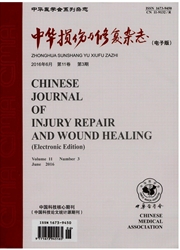

 中文摘要:
中文摘要:
目的探讨脉搏轮廓心排血量(PiCCO)监测技术在成批特大面积烧伤患者延迟复苏中的应用效果。方法对2014年8月苏州大学附属第一医院、解放军第一00医院及苏州市立医院收治的昆山爆炸事故中41例特大面积烧伤患者的临床资料进行回顾性分析。根据患者延迟复苏的监测方法分为传统监测组22例和PiCCO监测组19例。统计2组患者人院后2h内,伤后第1、2、3个8h及第1个24h电解质、胶体、水输入量。计算2组患者人院后2h内,伤后第1、2、3个8h及伤后第1、2、3、4个24h的补液系数。统计2组患者伤后8、16、24、48、72、96h的尿量、平均动脉压(MAP)、中心静脉压(CVP),伤后24、48、72、96h的血乳酸、剩余碱、血细胞比容(HCT)及血小板计数。统计2组患者的并发症及死亡情况。对数据行重复测量方差分析、X2检验、t检验、Wilcoxon检验。计算2组41例患者伤后第1个24h补液系数和2的差值与伤后第2个24h补液系数和2的差值,伤后第3、4个24h补液系数和1的差值与伤后第2个24h补液系数和1的差值,对这3组差值行Pearson相关分析。结果(1)伤后第1个8h及第1个24h,PiCCO监测组患者电解质输入量明显多于传统监测组(Z值分别为-3.506、-2.654,P〈0.05或P〈0.01),余时间段2组患者电解质输入量相近(z值为-1.871~-0.680,P值均大于0.05)。伤后第2、3个8h及第1个24h,PiCCO监测组患者胶体输入量明显少于传统监测组(Z值为-4.720~-2.643,P〈0.05或P〈O.01),余时间段2组患者胶体输入量相近(z值分别为-2.376、-2.303,P值均大于0.05)。各时间段2组患者水输入量相近(z值为-1.959~-0.241,P值均大于0.05)。(2)入院后2h内与伤后第1、2、3个8h及伤后第1、2、3、4个24h,传统监测组患者的补液系数分别为(0.59±0.18)、(0.70±0.23)、(0.94±0.24)、(0.74±0.14
 英文摘要:
英文摘要:
Objective To investigate the effect of the application of pulse contour cardiac output (PiCCO) monitoring technology on delayed resuscitation of patients with extensive burn in a mass casualty. Methods The clinical data of 41 patients injured in Kunshan dash explosion hospitalized in the First Affiliated Hospital of Soochow University, the 100th Hospital of the People's Liberation Army, and Suzhou Municipal Hospital were retrospectively analyzed. The patients were divided into traditional monitoring group (T, n =22) and PiCCO monitoring group (P, n = 19) according to the monitoring technic during delayed resuscitation. The input volumes of electrolyte, colloids, and water of patients in the two groups within 2 hours after admission, the first, second, and third 8 hours post injury (HPI) , and the first 24 HPI were recorded. The fluid infusion coefficients of patients in the two groups within 2 hours after admission, the first, second, and third 8 HPI, and the first, second, third, and fourth 24 HPI were calculated. The urine volume, mean arterial pressure (MAP) , and central venous pressure (CVP) of patients in the two groups at post injury hour (PIH) 8, 16, 24, 48, 72, and 96 were recorded. The blood lactate, base excess, hematocrit (HCT) , and platelet count of patients in the two groups at PIH 24, 48, 72, and 96 were recorded. Complications and death of patients in the two groups were recorded. Data were processed with analysis of variance for repeated measurement, Chi-square test, t test, and Wilcoxon test. The deviations between figure 2 and the fluid infusion coefficients of the first or second 24 HPI, and the deviations between figure 1 and the fluid infusion coefficients of the second, third or fourth 24 HPI were calculated, and the three groups deviations were analyzed by Pearson correlation analysis. Results ( l ) The input volumes of electrolyte of patients in group P were significantly more than those in group T within the first 8 and 24 HPI ( with Z values res
 同期刊论文项目
同期刊论文项目
 同项目期刊论文
同项目期刊论文
 期刊信息
期刊信息
